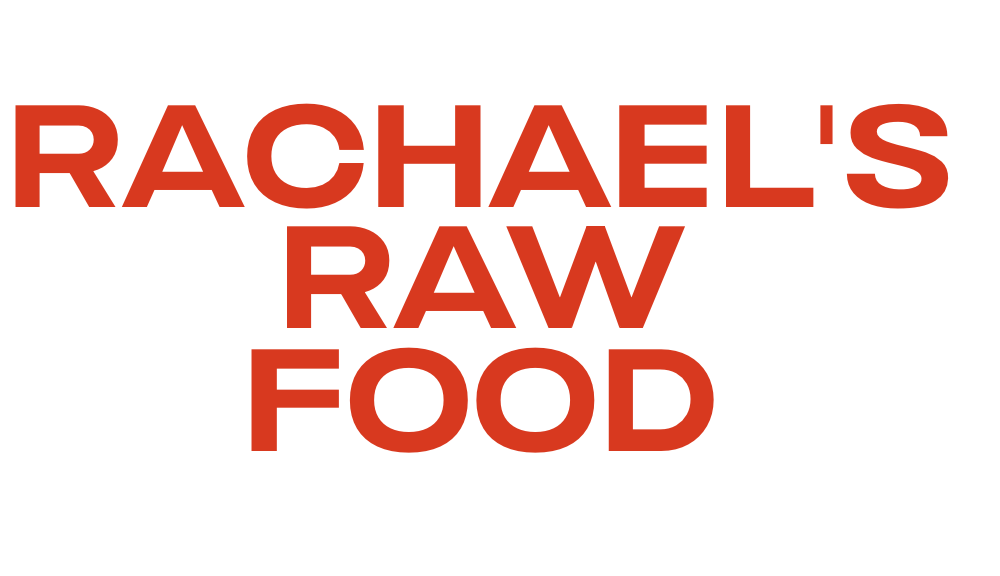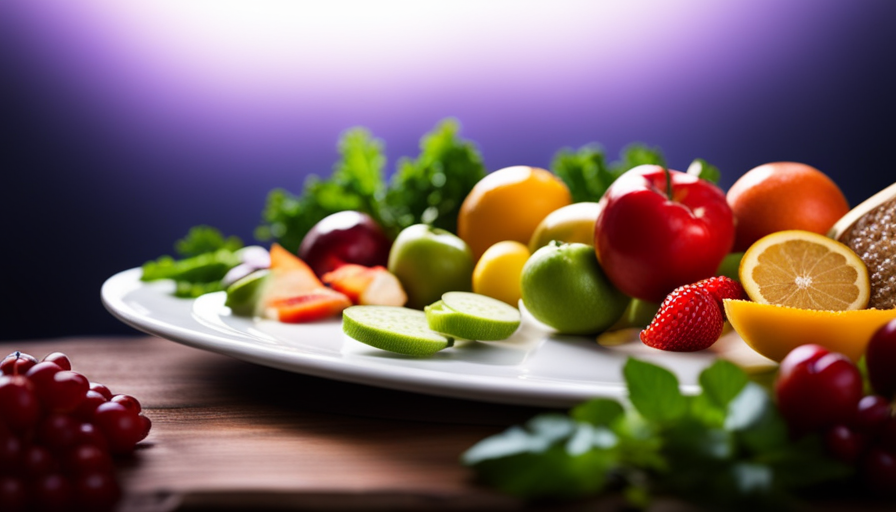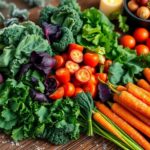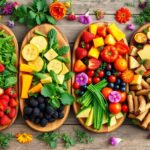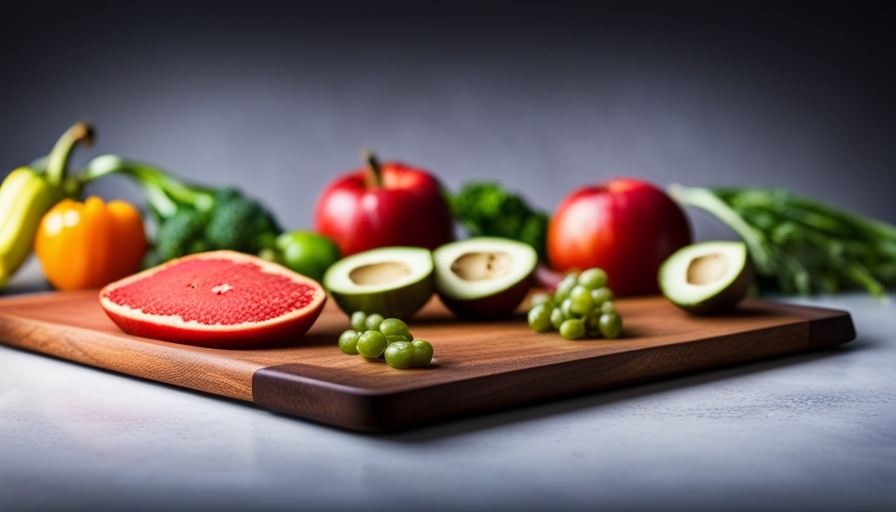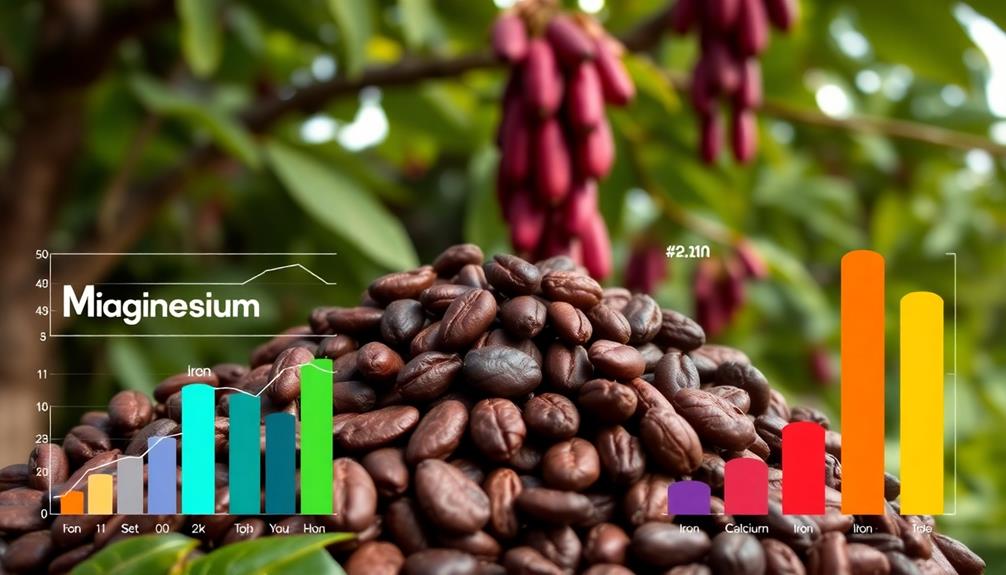Winter may bring cold temperatures and snowy landscapes, but that doesn’t mean you have to give up your raw food diet. Just like a determined seedling pushing through the frozen ground, you can find ways to enjoy fresh and healthy raw food during the winter months.
In this article, we will explore various strategies to obtain raw food in the winter, ensuring that you stay healthy and vibrant even when nature seems to be hibernating. From seeking out local farmers’ markets and community supported agriculture programs to growing your own sprouts and microgreens indoors, there are plenty of options to keep your plate filled with raw goodness.
We’ll also delve into the world of root cellars, foraging for winter edibles, incorporating winter vegetables and fruits, and adding nuts, seeds, and herbs to your diet. So bundle up, embrace the season, and let’s uncover the secrets to nourishing yourself with raw food all winter long.
Key Takeaways
- Farmers’ markets and community supported agriculture programs are great options for obtaining raw food in the winter.
- Indoor gardening, specifically growing sprouts and microgreens, is a viable way to have fresh produce during the winter months.
- Utilizing root cellars and cold storage can help preserve and store winter produce for longer periods of time.
- Winter foraging, when done safely and with knowledge of edible plants and fungi, can provide opportunities to find fresh food in natural environments.
Locating Farmers’ Markets and Community Supported Agriculture Programs
If you’re looking to support local farmers and get fresh produce, check out farmers’ markets and community supported agriculture programs. These are great options for locating farmers’ market alternatives and finding local winter produce suppliers.
Farmers’ markets are a popular choice for many people looking for fresh, locally sourced food. However, they may not be as readily available during the winter months. That’s where farmers’ market alternatives come in. Many communities have started to offer indoor markets, which are a great way to continue supporting local farmers and getting fresh produce even in the colder months. These indoor markets often feature a variety of vendors selling everything from fruits and vegetables to meats and dairy products.
Another option to consider is joining a community supported agriculture program, or CSA. CSAs allow you to directly support local farmers by purchasing a share of their harvest. Typically, you will receive a weekly or bi-weekly box of fresh produce throughout the growing season. Some CSAs also offer winter shares, which allow you to continue getting fresh produce even when the traditional growing season has ended.
To find these farmers’ market alternatives and CSAs in your area, start by checking with your local agricultural extension office or visiting websites that specialize in connecting consumers with local farmers. These resources can provide you with a list of options and help you find the best fit for your needs.
So, don’t let the winter season stop you from enjoying fresh, local food – explore farmers’ market alternatives and CSAs in your area today.
Growing Sprouts and Microgreens Indoors
To successfully cultivate sprouts and microgreens indoors during the winter, it’s essential to create a well-controlled environment that mimics optimal growing conditions. Indoor gardening allows you to have access to fresh, raw food even when it’s cold outside. One popular method for growing sprouts and microgreens indoors is by using hydroponic systems.
Hydroponic systems provide an efficient way to grow plants without soil. They use water-based solutions enriched with nutrients to nourish the plants. This method allows for faster growth and higher yields compared to traditional soil-based gardening.
To get started with indoor gardening, you will need some basic equipment such as trays, grow lights, and seeds. You can easily find these supplies at your local gardening store or order them online. Once you have your equipment, follow these steps:
- Soak the seeds overnight to initiate the germination process.
- Place the seeds in the trays and cover them with a thin layer of soil or growing medium.
- Set up the grow lights above the trays to provide the necessary light for photosynthesis.
- Maintain a consistent temperature and humidity level in the growing area.
By following these steps and providing the right conditions, you can enjoy a steady supply of fresh sprouts and microgreens throughout the winter months. It’s a rewarding and sustainable way to ensure you have access to raw food even when the weather is not conducive to outdoor gardening.
Utilizing Root Cellars and Cold Storage
Make the most of your harvest by utilizing root cellars and cold storage to preserve your fresh produce throughout the year. Root cellars have been used for centuries to store vegetables, fruits, and other perishables during the winter months. Building a root cellar requires careful planning and construction. The location should be cool, dark, and well-ventilated to maintain the ideal conditions for preserving winter produce.
To construct a root cellar, consider the following:
- Insulation: Use materials like straw, sawdust, or even old blankets to insulate the walls and floor. This helps regulate the temperature and humidity inside the cellar.
- Ventilation: Install vents or small windows to allow for proper air circulation. This prevents the buildup of moisture and helps maintain the freshness of your produce.
- Shelving: Build sturdy shelves to store your produce. Make sure they are spaced apart to allow for proper air circulation.
Preserving winter produce in a root cellar requires some knowledge and preparation:
- Sorting: Sort your produce and remove any damaged or spoiled items. This prevents the spread of rot and helps prolong the shelf life of the remaining produce.
- Storage: Different types of produce require different storage conditions. For example, root vegetables like carrots and potatoes prefer cool temperatures, while apples and pears prefer slightly higher humidity levels. Research the specific storage requirements of each crop to ensure maximum freshness.
By utilizing root cellars and cold storage, you can enjoy fresh produce throughout the winter months and reduce your reliance on store-bought options. With proper planning and care, your harvest can last for months, providing you with a taste of summer even in the coldest of winters.
Foraging for Winter Edibles
Venturing into the winter wilderness is like embarking on a treasure hunt, where the hidden gems are the delectable edibles just waiting to be discovered. Foraging for winter edibles can be a rewarding and sustainable way to get raw food during the colder months. To help you on your foraging journey, here are some tips and winter foraging locations to consider.
First and foremost, it’s important to educate yourself on the edible plants and fungi that thrive in winter. Some common examples include wintergreen, wild garlic, and oyster mushrooms. Familiarize yourself with their appearance and habitats to increase your chances of success.
When foraging in winter, it’s crucial to pay attention to safety. Make sure you’re dressed appropriately for the weather, wear sturdy boots, and carry a map or GPS device to avoid getting lost. Additionally, always forage from pollution-free areas and be mindful of any potential hazards, such as icy terrain.
Here is a table showcasing some winter foraging locations:
| Location | Description | Edibles Found |
|---|---|---|
| Forests | Abundant with various plants and fungi | Wintergreen, oyster mushrooms |
| Meadows | Open spaces with diverse vegetation | Wild garlic, cattail roots |
| Coastal areas | Rich in seaweed and coastal plants | Dulse, sea lettuce |
Remember, foraging in winter requires patience and careful observation. Take your time, be respectful of nature, and enjoy the thrill of discovering nature’s winter bounty. Happy foraging!
Making Use of Winter Vegetables and Fruits
Explore the delicious possibilities of winter produce and fruits, and discover how to make the most of these seasonal treasures. Winter gardening can be a rewarding way to enjoy fresh and nutritious food during the colder months. Here are three ideas to help you make use of winter vegetables and fruits:
-
Roasted Root Vegetables: Winter is the perfect time to indulge in hearty and warming dishes. Roasting root vegetables like carrots, parsnips, and sweet potatoes brings out their natural sweetness and enhances their flavors. Simply toss them in olive oil, sprinkle with salt and pepper, and roast in the oven until tender and caramelized. These roasted veggies make a delicious side dish or can be added to salads, soups, or stews.
-
Citrus Salads: While most fruits are out of season during winter, citrus fruits like oranges, grapefruits, and lemons are at their prime. Create refreshing and vibrant citrus salads by combining different varieties of citrus fruits with fresh greens, such as arugula or spinach. Add some toasted nuts, crumbled cheese, and a tangy vinaigrette for a delightful burst of flavors.
-
Seasonal Recipes: Winter is the time to experiment with comforting and hearty recipes. Try making a warming butternut squash soup, a creamy cauliflower gratin, or a roasted beet and goat cheese salad. Incorporating winter vegetables into your meals not only adds variety but also ensures you’re getting essential nutrients during the colder months.
By embracing winter gardening and exploring seasonal recipes, you can enjoy a diverse array of fresh and nutritious food even during the coldest months of the year.
Exploring Fermentation and Pickling Techniques
Enhance your culinary creations by experimenting with the art of fermentation and pickling, bringing a tangy twist to your winter dishes. Fermentation is a natural process that not only preserves food but also enhances its nutritional value. During fermentation, beneficial bacteria break down sugars and produce lactic acid, which not only gives fermented foods their tangy flavor but also helps improve digestion and boost the immune system. Incorporating fermented foods into your winter diet can help support your overall health.
When it comes to pickling, there are countless recipes that you can try using winter vegetables and fruits. Pickling involves preserving food in a solution of vinegar, salt, and spices, which not only extends the shelf life of the food but also adds a burst of flavor. From pickled beets and carrots to pickled apples and pears, the possibilities are endless. Experiment with different pickling spices such as dill, mustard seeds, and cloves to create unique flavor combinations.
To get started with fermentation and pickling, make sure to use fresh and high-quality produce. Clean and sterilize your jars, and use non-iodized salt for pickling. Follow recipes closely and give your fermenting and pickling projects time to develop their flavors. The end result will be a variety of tangy and delicious fermented and pickled foods that will add an exciting dimension to your winter meals.
Incorporating Nuts and Seeds into Your Diet
Add a nutritious and flavorful twist to your meals by incorporating a variety of nuts and seeds into your diet this season. Not only do nuts and seeds provide a satisfying crunch, but they also offer a wide range of health benefits. When it comes to incorporating raw food into your winter diet, nuts and seeds are a great option.
Incorporating nuts and seeds into your diet during the winter months can help you stay nourished and energized. They’re packed with essential vitamins, minerals, and healthy fats that can strengthen your immune system and support overall well-being. Plus, they’re versatile and can be easily added to salads, smoothies, or enjoyed as a snack on their own.
Walnuts, for example, are rich in omega-3 fatty acids, which are known for their anti-inflammatory properties. They can help reduce the risk of chronic diseases and improve brain health. Chia seeds are another excellent choice as they’re high in fiber and can aid in digestion. They also provide a good source of plant-based protein.
By incorporating nuts and seeds into your winter diet, you can enjoy the benefits of raw food even when fresh produce is scarce. So, go ahead and experiment with different nuts and seeds to add nutritional value and a delightful crunch to your meals this season.
Trying Raw Soups and Warm Smoothies
To create a cozy and nourishing experience this season, imagine yourself savoring a piping hot bowl of raw soup or indulging in a velvety warm smoothie.
Raw soup recipes are a fantastic way to incorporate raw foods into your winter diet. Not only do they provide essential nutrients and enzymes, but they also warm you up from the inside out. One popular raw soup recipe is a creamy tomato soup made with fresh tomatoes, avocados, and various spices. Another option is a vibrant carrot ginger soup, which combines the sweetness of carrots with the zing of ginger. These raw soups can be easily prepared by blending the ingredients together and then gently heating them on the stove.
Warm smoothies are another great option for enjoying raw food in the winter. While cold smoothies may not be as appealing when the temperatures drop, warm smoothies offer a comforting and nutritious alternative. They can be made by blending fruits, vegetables, and warm liquids such as herbal teas or almond milk. Warm smoothies provide all the benefits of their cold counterparts, including vitamins, minerals, and antioxidants. They also help to keep you hydrated during the winter months.
Incorporating raw soups and warm smoothies into your winter diet can be a delicious and nutritious way to enjoy raw foods. So, why not give these recipes a try and experience the nourishing warmth they provide?
Experimenting with Raw Desserts and Treats
Indulge in the decadent world of raw desserts and treats, where creamy chocolate mousse, chewy almond butter cookies, and luscious strawberry cheesecake bars await to satisfy your sweet tooth and transport you to dessert heaven. Experimenting with raw desserts can be a delightful way to enjoy healthy, unprocessed treats even during the winter months.
-
Rich and Decadent Flavors: Raw desserts aren’t just delicious, but they also offer a wide range of flavors that’ll leave you craving for more. From velvety chocolate to tangy citrus, these desserts are bursting with natural flavors that’ll tantalize your taste buds.
-
Nutrient-Packed Ingredients: Raw desserts are made with wholesome ingredients like nuts, seeds, and fruits that’re packed with essential nutrients. These ingredients provide a good dose of vitamins, minerals, and antioxidants while satisfying your sweet cravings.
-
Easy and Quick Recipes: Experimenting with raw desserts doesn’t have to be complicated or time-consuming. There’re plenty of simple and quick recipes available online that require minimal preparation and no baking. With just a few ingredients and a blender or food processor, you can whip up a delicious raw dessert in no time.
So, why not try your hand at creating decadent raw desserts this winter? Not only will you satisfy your sweet tooth, but you’ll also nourish your body with wholesome ingredients. Give it a go and discover a whole new world of guilt-free indulgence!
Staying Hydrated with Herbal Teas and Infusions
Quench your thirst and stay hydrated this winter by enjoying a warm cup of herbal tea or infusion. Studies have shown that herbal teas can boost your immune system and provide a comforting sense of relaxation. Not only do they keep you hydrated, but they also offer various health benefits.
Herbal teas are made by infusing dried herbs, flowers, or fruits in hot water. They are caffeine-free and come in a wide range of flavors, making them a delicious and healthy alternative to sugary drinks. Additionally, herbal teas are rich in antioxidants, which can help reduce inflammation and protect against chronic diseases.
To make a refreshing herbal infusion, simply steep your favorite herbs in hot water for a few minutes. You can experiment with different combinations to create unique flavors. Here is a table with some popular herbs and their health benefits:
| Herb | Health Benefits |
|---|---|
| Chamomile | Promotes relaxation |
| Peppermint | Aids digestion |
| Ginger | Eases nausea |
| Echinacea | Boosts the immune system |
| Lavender | Relieves stress and anxiety |
By incorporating herbal teas and infusions into your winter routine, you can stay hydrated while enjoying their numerous health benefits. So, why not try a cup of chamomile or peppermint tea today and experience the soothing and refreshing effects for yourself?
Frequently Asked Questions
Can I still find fresh, raw fruits and vegetables in the winter?
Yes, you can still find fresh, raw fruits and vegetables in the winter. Winter gardening tips can help you locate these nutritious options. Look for local farmers’ markets or grocery stores that prioritize seasonal produce.
Additionally, you can grow your own fruits and vegetables indoors or in a greenhouse. Opt for cold-hardy crops like kale, spinach, and root vegetables.
By following these tips, you can ensure a steady supply of fresh produce even during the winter months.
How do I know if the farmers’ market or community supported agriculture program near me sells raw food?
To find out if the farmers’ market or community supported agriculture program near you sells raw food, start by researching local farmers in your area. Look for farmers who specialize in growing fruits and vegetables without using pesticides or chemicals. These farmers are more likely to offer raw, organic produce.
Additionally, community supported agriculture programs often provide a variety of fresh, raw produce directly from local farmers. Participating in these programs can not only support local agriculture but also provide you with the benefits of eating fresh and nutritious food.
What are some common mistakes to avoid when growing sprouts and microgreens indoors?
To ensure successful growth of sprouts and microgreens indoors, it’s important to avoid some common mistakes. First, avoid overwatering, as it can lead to mold or rot.
Also, make sure to provide adequate light by placing them near a sunny window or using grow lights.
Another mistake is overcrowding the seeds, which can hinder their growth.
Lastly, maintain proper ventilation to prevent the buildup of humidity.
By avoiding these mistakes, you can enjoy a thriving indoor garden.
Are all types of fruits and vegetables suitable for root cellars and cold storage?
Not all types of fruits and vegetables are suitable for root cellar storage and cold storage. Some fruits and vegetables, such as apples, potatoes, carrots, and onions, are ideal for winter storage due to their ability to withstand colder temperatures and maintain their freshness.
However, other types, like tropical fruits and delicate leafy greens, are not recommended for long-term storage in root cellars. It’s important to choose winter produce that’s known for its storage capabilities to ensure availability throughout the season.
Are there any safety concerns or precautions to take when foraging for winter edibles?
When foraging for winter edibles, it’s important to be aware of safety concerns and take necessary precautions.
First, make sure you can confidently identify the plants you are collecting. Some edible plants have poisonous look-alikes.
Avoid areas that may have been contaminated with pesticides, pollutants, or harmful chemicals.
Dress warmly and wear appropriate footwear to protect yourself from the cold and slippery conditions.
Lastly, always harvest responsibly and sustainably.
Can I Still Get Fresh Raw Food in Winter Even If I Can’t Eat It Raw?
Yes, you can still get fresh raw food in winter even if you can’t eat it raw. With the eating raw food winter guide, you can find fruits and vegetables that are in season and use them for cooking, juicing, or blending. Winter doesn’t have to stop you from enjoying fresh, healthy foods.
Conclusion
In conclusion, you now have a variety of options to get raw food during the winter months. By utilizing farmers’ markets and community supported agriculture programs, you can access fresh produce directly from local farmers.
Growing sprouts and microgreens indoors allows you to have a constant supply of nutritious greens.
Root cellars and cold storage are excellent for storing root vegetables and fruits.
Foraging for winter edibles adds adventure to your food journey.
Don’t forget to incorporate nuts, seeds, and winter vegetables into your diet.
And lastly, warm up with raw soups, smoothies, and delicious desserts. Stay hydrated with herbal teas and infusions.
With these tips, you can enjoy a healthy and vibrant winter diet.
